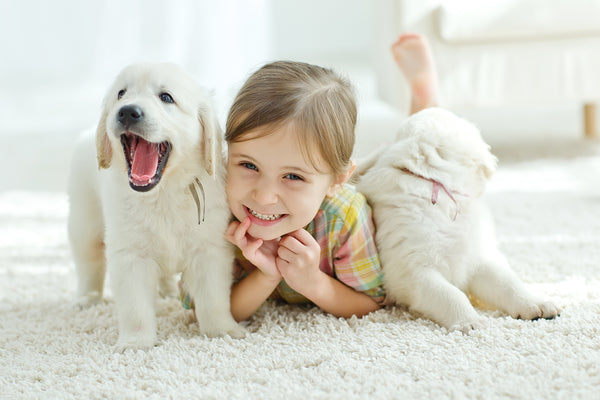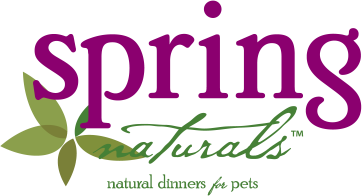
A Potty Training Guide for Puppies
A Potty Training Guide for Puppies
If you’ve recently brought home a fluffy, snuggly pup, you’re probably already trying different ways to encourage him or her to go potty outside. Not on your carpet!
Or maybe you’re thinking of getting a new pup soon and want to make sure you’re prepared for the potty training before it even begins. Good for you!
It’s important for new puppy owners to learn about puppy training stages right away. In the natural order of things for wolves and dogs, mama dogs teach their pups everything they need to know about their world. Pups learn early about living together in a den, leaving the den to relieve themselves, and who to snuggle up to for a snack.
So now that is going to be your job!
All puppies need training. No matter if you get your puppy at 8 weeks old, 16 weeks old, 6 months old or an older dog from a shelter. When a new pet comes to live with you, it’s up to you to show him or her the way of the human home. That includes where to sleep, when to eat, and how to go potty outside.
The general strategy for potty training includes: establish a strict routine, offer potty breaks throughout the day and after specific activities, supervise your puppy at all times, crate your puppy when he or she is not supervised, and ensure your puppy is receiving high quality food to normalize bowel movements.
Start Practicing a Daily Routine
Animals have a natural, internal clock. Their daily rhythms are what help puppies to know when to wake up, when to go potty, when to eat, and when to play.
Help your puppy adjust to living in your home by establishing a consistent routine right away. It doesn’t matter exactly what times of day each behavior takes place. It does help to keep things in the same order and around roughly the same time each day.
Set a Daily Routine
As you make a routine for your puppy, consider your own routine. When do you leave for work? When do you come home? Will you be able to come home in between for potty breaks while your puppy is still young? When do you typically like to relax and have quiet time? When do you like to be active, go for a walk, exercise, or play with the family and pup?
Here is a sample order of events to help you set your puppy’s daily routine:
- Immediately after waking up, take your puppy to the designated potty area.
- Enjoy 5 minutes of playful romping or letting puppy sniff around the yard area.
- Time for breakfast – rather than leaving your puppy’s food dish full all day for him to graze, offer set mealtimes with access to food for about 30 minutes. Then pick up the bowl.
- Post-breakfast potty break (puppies usually need to poop right after eating)
- Play on his own while you get yourself ready for your own day.
- Just before you leave for work, offer a late morning potty break one more time.
- Put puppy into his crate or safe play area while you work.
- Lunch time around 2-3 hours from breakfast for young puppies, between 8-16 weeks old.
- Potty break - puppies can generally “hold it” for just a couple of hours at a time. By 10 weeks, with a good routine it’s reasonable to think your puppy can “hold it” for about 3-4 hours during the day or 5-6 hours overnight. Yes, that means if you work a typical 8-10 hour shift, you’ll need to come home or have a pet sitter pop by around lunchtime for a potty break.
- Playtime
- When you come home from work/school, potty break
- Playtime & training
- Dinner & potty break
- Play on his own in his play area while you relax nearby
- Potty break
- Bedtime
- Possible middle of the night potty break
Potty Training Tips
Here are some more specific strategies for potty training your pup:
- Stick to a strict routine like the one above.
- The first two days after bringing home your new dog, set a timer to take him out to the designated potty spot every 2 hours, and reward any relief in the right spot with praise and play.
- If your dog has an accident inside the house or crate, never punish. Simply try to interrupt with a clap and running to the outdoor spot, or simply take pup outside and clean up the mess.
- I discourage the use of potty pads, as they are more often a crutch that makes potty training more confusing for puppies than helpful. They have their time and place if used properly for training or aiding in medical situations, but they are typically more messy than they are worth for typical housebreaking.
- Always offer a potty break after your pup wakes up (even from a short nap), eats, drinks, has a heavy bout of playtime or comes out of the crate (even if he just went out recently!)
- During potty breaks, I don’t recommend leaving puppy outside alone for along period of time. Instead, go out and walk around the yard quietly while you wait for hi to do his business. Then bring puppy inside. It also helps establish potty time if your puppy learns that his potty break is a set amount of time, rather than being left outside on his own for an hour or so. Puppies easily get distracted in the yard playing and sniffing, and some of them will forget to poop until it’s time to go back inside. Then he’ll realize he never went potty and he’ll relieve himself inside after he’s calmed down.
Should You Use a Crate?
As a trainer and pet owner alike, I highly recommend training your dogs to settle in a crate of his/her own. Dogs do genuinely enjoy having a space of their own, like a den, in which they can retreat, rest, or feel safe in the event of stressful situations.
Potty training is much easier when you use a crate.
It will also make your life as a pet parent much easier if you have the option to secure your pet in certain situations. For example, when guests come to visit, your pet can be crated to keep your guests safe from your puppy’s jumping and nipping. When your dog gets older and larger, it’s also a good idea to be able to crate your dog when guests are visiting, at least until they settle down and get used to the presence of guests in the home.
So, how do you use a crate as part of potty training?
First, crate training plays on the natural disinclination for dogs to soil their den. If a dog is in a small crate, he is much less likely to pee or poop while he’s in it, helping him learn to gain control over his bladder and bowel.
Second, if your dog does have an accident in the house, cleaning up a mess from a crate is much easier than cleaning your carpet, furniture, or potentially staining a hardwood floor.
How to Crate Train Your Pup
- Starting with the crate door propped open, set a new toy inside before you bring puppy over. Then toss a few treats inside.
- Let your puppy explore the crate, toys and treats on his or her own. Keep the door open the whole time and let her wander comfortably. Having a surprise inside the crate will trigger your pup to want to check out the crate every so often over the next few days to see if any new toys appeared magically.
- Over the next day or two, toss treats occasionally into the crate to allow your pup to continue finding surprises there.
- Once your puppy is good and comfortable walking in and out of the crate on her own, you can start training her to go in without luring her with treats first. You can indicate with your hand for puppy to go inside, then close the door and give a treat. Then open the door back up and start the game over.
- You can continue the crate training game over the next few days in the same way – indicating for your pup to go into an empty crate, shut the door, offer a treat. Leave pup in the crate for longer and longer periods of time over the next few days, building up to 30 minutes, then an hour while you leave for a short time. You can offer fun toys to keep him/her busy, but make sure they are safe to leave unsupervised. No stuffed toys or ropes that can be shredded and ingested!
- Once your puppy is crate trained thoroughly, you can cate him every time you leave the house to help with potty training.

Your Dog’s Food Plays a Role in Potty Training
I worked in a pet store for years, learning about different dog foods and understanding pet owners’ biggest concerns, needs, and complaints. The first thing to understand about the relationship between dog food and potty training is this:
Higher quality, grain-free dog food produces firmer, smaller stool.
Low quality food that contains filler and grain is tougher on the gut to digest. With our Spring Naturals high quality, grain-free dog food, dogs can eat less to get the nutrients their bodies crave. More food is digested properly, so a lower proportion of waste is produced.
Less poop means fewer trips outside during potty training. Firmer poop is easier to maintain control of bowels during potty training.
If your dog is having diarrhea or irregular bowel movements from day to day, consider the type of food. Talk to your vet about possible food allergies and digestive irritants. These will make your dog’s urge to go higher and more frequent, making potty training and crate training more difficult. Spring Naturals grain-free dog food are limited ingredient, making it easier to identify a meal that suits your dog’s digestive system.
References
“Early Puppy Training” CL Battaglia. Breeding Better Dogs.
Periods of early development and the effects of stimulation and social experiences in the canine. CL Battaglia. Journal of Veterinary Behavior, 2009.
Don't Shoot the Dog: The New Art of Teaching & Training. Karen Pryor. 2006.

Post a Comment!